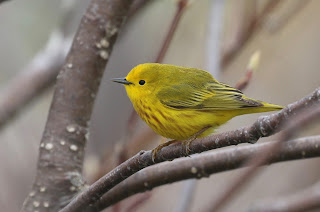Sometime in late 2016 I day-dreamed of doing a "big year" at one of my local patches: Quidi Vidi lake in St. John's. It's a well-known hotspot for gulls throughout the winter and has attracted an impressive list of vagrants over the decades. I always felt that the lake was neglected through the Spring, Summer, and Autumn and a big year would motivate me to check the area throughout the year.
Christmas day, 2016, came along and bestowed upon us a Kelp Gull at the lake which kept many of us busy studying the gull flocks throughout early 2017. Then I had a placement at a nearby hospital meaning I was "forced" to walk by the lake every morning in January. In the end, I had no choice but to do a pseudo big year at the lake.
The unofficial borders of the patch are drawn out by the surrounding road which has a total circumference of 4.1 km (see blue line in picture below). Luckily, I live a mere 1.1km from the lake and it takes me less than 3 minutes to get there by bike.
In total, I visited the lake over 120 times. In a real big year, I really should have been there 300+ days in the year but I was out of the province for at least 100 days so a true big year wasn't feasible.
My year list ended at 90, and in total an even 100 species were recorded at the lake in 2017. I was really hoping for 100 on my personal list, and it really would be possible. My excuse is that I missed the key months of the year (May, June, and Oct). This brought my QV life list to 113.
15 species were added to the overall Quidi Vidi list, bringing it to a respectable 162 species. Of those 15 new species, I self-found 12 of them :)
Although I saw less than I had hoped I did learn a lot about several key micro-habitats around the lake, particularly on the South side of the lake which is rarely walked by birders. This is where I came across most of the more unusual species: Downy Woodpecker, Blue-headed Vireo, Blue-gray Gnatcatcher, Lapland Longspur, Orange-crowned Warbler, Yellow-breasted Chat (x2), and Lincoln's Sparrow.
The rarest bird of the bunch was easily the Common Swift found by Ian Jones & Jeannine Winkel on May 20th. I was lucky to be flying back from Vienna the next day and managed to get several excellent looks of the bird myself. Not only was this the best bird for the lake in 2017 but I would say it was easily the best bird of 2017 for the entire island! It was last seen on the 25th of May.
Common Swift - 21 May 2017 @ QV lake
My favourite sighting though was an adult Northern Gannet! This bird flew low over the path on the South side of the lake flying right above the heads of Sebastian Pardo and myself. I couldn't believe my eyes! Although it is a very common species a mere 800m away I never expected to see one flying over the lake, let alone flying directly inland. We watched it fly towards the Dominion grocery store and out of sight.
Buddy v2.0
The "original" Buddy is a Lesser Black-backed Gull that has returned to the West end of QV since its first year of life in 2009. It continues to beg for bread to this day. Buddy v2.0 first arrived in the Autumn of 2016 and not only spent the entire winter with the original buddy, but also over-summered at this location - the only record I'm aware of of a LBBG over-summering in St. John's.
QV is by far the best spot for Yellow Warblers that I've ever birded on the island.
Song Sparrows have an interesting story on the Avalon peninsula. 30 years ago they were an uncommon species with summer breeding records being a notable observation. Their numbers have since steadily grown and they're now an expected species in all suitable locations. Quidi Vidi, for unknown reasons, is the "stronghold" of this species and has consistently had at least 10+ singing males in the Spring and early Summer. A far higher concentration than anywhere else I've experienced.
A pretty obvious trend!

Two Black-bellied Plovers spent 20 days at the lake and became very tame allowing for an excellent opportunity to study this otherwise wary species.
Most visits to the lake were during the early morning hours. I was rewarded with many spectacular sunrises :)
A Palm Warbler at the lake was my only observation of this species for 2017.
A Blue-gray Gnatcatcher with a flock of 3 warblers in late November was a surprise addition to my QV list.
This Lincoln's Sparrow, found by Frank King, was only the second ever seen at the lake.
Quidi Vidi has the largest concentration of dabbling ducks in the city, most of which live out the year at the West end awaiting handouts. This flock of hybrid, mutants, and farmyard varities draws in other more "genuine" dabblers including Northern Pintails...
... and both American and Eurasian (shown) Wigeon
White-throated Sparrow
An Iceland Gull cruises through the first snowstorm of the 2017/2018 winter.
The real question is what will I do in 2018?!
Perhaps this will give a clue into what I'm thinking about:
An early summer Herring Gull




















